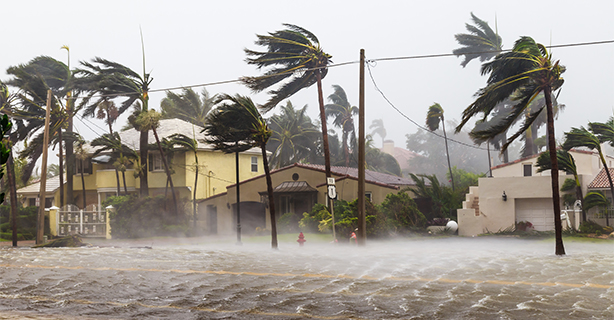Keeping your car safe during a hurricane
0 min. read
If you live in an area prone to hurricanes, part of being prepared is making sure your car is protected when a hurricane strikes. There are several steps you can take to help keep your car safe and get back on the road after the storm.
How do you protect your car from a hurricane?
To protect your vehicle during a hurricane, park it in a place that protects it from flooding, hail, and flying debris caused by high winds. It’s also a good idea to fill up the gas tank and place tape on the windows. Following these steps helps ensure your car is prepared to weather the storm.
Where should you park your car during a hurricane?
As a hurricane approaches, choose a parking location that can withstand the variety of risks the storm brings with it.
Find a parking garage
If there's one close by, a parking garage is an ideal place to park your car during a hurricane. Parking garages are typically very sturdy, and they offer shelter from blowing and falling objects. As an added bonus, the higher levels offer protection from flooding as well.
Take cover
Even if you don't have access to a parking garage, you can still keep your vehicle safe by parking it in a place with walls and a roof like a garage or shed. This helps protect it from hazards like hail and flying debris.
Shelter next to a building
If parking inside isn't an option, parking next to a building or other sturdy structure can help block debris from striking the side of your car.
Avoid falling objects
When parking outside, choose an area away from trees, power lines, light poles, advertising signs, and other objects that could blow over in high winds.
Head for high ground
Between 2011 and 2021, Dairyland® saw an average increase of more than 527 percent in flood damage claims during hurricane season compared to the rest of the year. Floods tend to inflict their strongest damage at lower elevations, so look for parking options at higher elevations, out of reach of rising flood waters brought on by the hurricane.
How to prepare your car for a hurricane
Protecting your vehicle during a hurricane isn’t just a matter of finding a good parking spot. It’s also a good idea to:
Fill up your gas tank
Get to a gas station and fill your car up as soon as you learn there’s a storm on the way. As a hurricane approaches, many people stock up on fuel for their vehicles and backup generators, so a shortage may occur. Also, the power may be out after the storm, making it impossible to pump gas at most gas stations.
Remove important items
Protecting your car is obviously a priority, but keep in mind, you probably have other valuables inside the vehicle as well. Take any valuable or important items out of your car and store them in a safe place in case something happens to your car during the storm. It’s a good idea to make copies of important documents like registration and insurance, even if it means just taking a picture of the documents with your cell phone.
Is it safe to drive during a hurricane?
No, you shouldn’t drive during a hurricane. We strongly advise staying off the roads and finding a safe place to seek shelter.
If you must venture out during the storm, use extra caution while driving. Power will likely be out, meaning there’ll be no traffic signals. Watch for road hazards and downed power lines.
If a road is flooded, don’t attempt to drive through it. You can’t see any hazards beneath the water, and even just a foot of water can cause a vehicle to float away. Six inches of water will likely reach the bottom of most cars, leading to loss of control and stalling. Follow the National Weather Service’s advice: “Turn around, don’t drown.”
Getting back on the road after a hurricane
If your car is harmed during the storm, take pictures and compile a list of the damage once the storm is over. This can help speed the claims process along and get you back on the road as soon as possible.
Get in touch with your auto insurance company as soon as you can. The storm will leave many other drivers in the same situation. Acting quickly helps you beat the rush to file a claim and get your car to a repair shop.
Related links
If something bad does happen to your vehicle during a hurricane, do you know what do to next? Let us help you through the claim process.
If you need to get around while damage to your car is being repaired, it’s good to know whether or not your insurance policy covers rental cars.
The general information in this blog is for informational or entertainment purposes only. View our blog disclaimer.
*Data accuracy is subject to this article's publication date.







